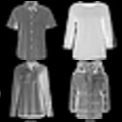Quantum computing-based machine learning mainly focuses on quantum computing hardware that is experimentally challenging to realize due to requiring quantum gates that operate at very low temperature. Instead, we demonstrate the existence of a lower performance and much lower effort island on the accuracy-vs-qubits graph that may well be experimentally accessible with room temperature optics. This high temperature "quantum computing toy model" is nevertheless interesting to study as it allows rather accessible explanations of key concepts in quantum computing, in particular interference, entanglement, and the measurement process. We specifically study the problem of classifying an example from the MNIST and Fashion-MNIST datasets, subject to the constraint that we have to make a prediction after the detection of the very first photon that passed a coherently illuminated filter showing the example. Whereas a classical set-up in which a photon is detected after falling on one of the $28\times 28$ image pixels is limited to a (maximum likelihood estimation) accuracy of $21.27\%$ for MNIST, respectively $18.27\%$ for Fashion-MNIST, we show that the theoretically achievable accuracy when exploiting inference by optically transforming the quantum state of the photon is at least $41.27\%$ for MNIST, respectively $36.14\%$ for Fashion-MNIST. We show in detail how to train the corresponding transformation with TensorFlow and also explain how this example can serve as a teaching tool for the measurement process in quantum mechanics.
翻译:以量子计算为基础的机器学习主要侧重于量子计算硬件,由于需要低温运行的量子门,这种硬件在实验中具有挑战性,难以实现。相反,我们通过精确度Vs-quits图展示出一个低性能和低得多的努力岛屿,这个精确度Vs-quits图很可能通过室温光学实验获得。这种高温的“量子计算玩具模型”仍然令人感兴趣,因为它允许对量子计算中的关键概念,特别是干扰、缠绕和测量过程进行相当容易理解的解释。我们特别研究从MNIST和时装-MNIST数据集中对一个示例进行分类的问题,我们不得不在检测第一张通过连贯的透视过滤器显示的精确度后作出预测。而一个典型的设置,在跌落到28美元图像像像像像像像像像像像像像样模型之一后,检测到MNI科技的精确度(最有可能估计)为21.27美元(美元)的精确度,分别是18.27美元(美元)美分,在FMNI-MNI国际信息系统中,我们展示了在光学上最差的精确度上如何显示,而可以分别转换。





